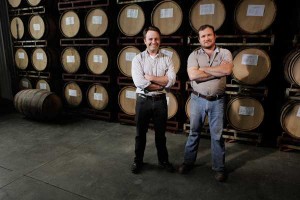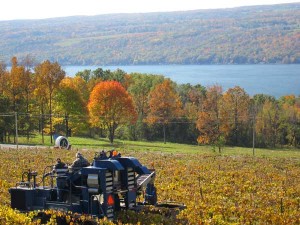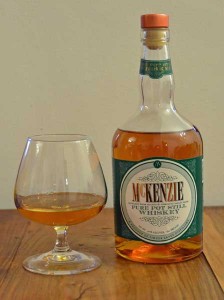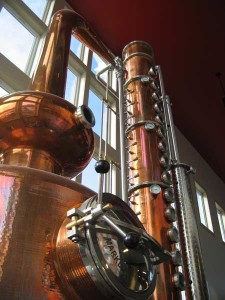Q&A with Finger Lakes Distillery
An Interview with Brian McKenzie, Co-Founder of Finger Lakes Distillery
By Richard Thomas

and Thomas McKenzie
(no relation)
(Credit: Finger Lakes Distillery)
New York State has become one of the busiest parts of the Union in the micro-distillery boom, and among the busiest and best-known of New York’s small whiskey-makers is Finger Lakes Distillery. Outside of New York State, you might be hard-pressed to find one of the variety of whiskeys produced by Finger Lakes, as its wider distribution is limited (for now, anyway) to just a few places in New Jersey, Illinois, and Pennsylvania. It is therefore safe to say that Finger Lakes’ reputation has spread far beyond the reach of their actual products, and The Whiskey Reviewer was fortunate to catch-up with distillery co-founder Brian McKenzie.
RT: Finger Lakes has a big investment in being green. You use recycled water and heat; rely partially on locally grown, organic grain; and even your buildings use reclaimed wood. How does that commitment effect your whiskey-making?

(Credit: Finger Lakes Distillery)
BM: Our biggest commitment in this regard, is with sourcing our ingredients locally. As a NYS Farm Distillery, we source about 90% of our ingredients from the region. We are located in a wonderful agricultural area, so this has helped us make good quality spirits. As for staying green, we do what we can to minimize the environmental impacts of our business.
RT: You have a very diverse line, and each part of it seems to have its own special twist. For example, you have a fairly high-corn Bourbon, made with heirloom corn, that is small barrel aged and finished in Chardonnay barrels. How do you come up with something like that? How much is inspiration and imagination, and how much is experimentation?
BM: Most of our line was created from inspiration from Thomas, our Distiller, and me, and not random experimentation. We wanted our product line to reflect our presence in Wine Country – thus, the grape-based vodka, gins, liqueurs/brandies and our wine-barrel finished whiskeys. The great thing about being a micro-distiller is that you can make some small batches and see how the consumer responds. We’ve had a lot of fun playing with different grains in our mashbills (i.e. spelt in White Pike Whiskey), utilizing the great range of fruits available for liqueurs and brandies, and experimenting with the dozens of grape varietals that are available here in the Finger Lakes. Our primary focus is on Whiskey, however, and we’ve got some other styles we’ll be releasing in the next few years including a Wheated Bourbon, Straight Wheat Whiskey and a Single Malt.
RT: Tell us about that American Single Malt?

from Finger Lakes Distillery
(Credit: Richard Thomas)
BM: We’ve got quite a bit of Single Malt aging in our barrel room – the oldest being about 4.5 years. With the NYS requirement of sourcing predominately from local farms, this product has been a challenge since we are just starting to see some NYS malt houses. Our first batches contained barley that we malted ourselves, some of which was even smoked with peat from a local bog. Since then, we’ve found we don’t have the time to malt ourselves, so we’ve sent some NYS barley to a malter over the border in Mass. The State just introduced a new Farm Brewery license so we are hopeful that NYS malt will be easier to come by over the next few years.
RT: What does the immediate future of Finger Lakes hold more generally? Is there a new McKenzie whiskey on the horizon, or are you expanding into any new markets?
BM: I’ve mentioned our new whiskeys. We just launched our product line with a new distributor – Winebow – which will expand our reach into some new markets including MA, CT, IL, NJ, DC and MD. We’ve been cautious not to expand distribution too quickly so that our whiskey stocks can keep up with demand. As we grow, we hope to enter new markets in the U.S. and possibly beyond.
RT: Many micro-distilleries produce small barrel aged whiskey and white whiskey, two things that don’t require years spent maturing on a warehouse rack before going to market. Some pundits are harshly critical of both practices, like Chuck Cowdery, who labeled small barrel whiskeys as “lousy.” Finger Lakes produces three small barrel and two clear whiskeys, so what do you think when someone says these practices produce an inferior product?

(Credit: Finger Lakes Distillery)
BM: We fall somewhere in the middle of the small barrel debate. We’re proud of the whiskey we’ve released out of our 10 gallon casks, but I think there is something to be said for more extended aging in larger barrels. As much as we respect Chuck’s opinion on most matters, I think it’s tough to characterize all small barrel whiskey as “lousy.” I’ve had a few that are quite good and several that are not. Here at FLD, we realized there were some limitations with this technique and have tried to offset with some different strategies such as aging at lower proof, different char levels and finishing whiskey in wine casks like our Rye (sherry) and Bourbon (Chardonnay). We also don’t use barrels smaller than 10 gallon and age at least a year or more. All that being said, we are rapidly transitioning our aging program from small barrels to standard 53 gallon barrels. In fact, our last batches of rye and bourbon contained at least 50% of the spirit from 53 gallon barrels aged 3-4 years. We’re targeting our Bourbon as a traditional 4 year old straight bourbon (some will be held for longer aging). We think the rye tastes good a little younger at 2-3 years, though we’ll hold some of that back for longer aging as well. There is no question you can pick up the oak influence much faster in the smaller casks, but the whiskey also needs to oxidize and that takes time.
As for white whiskeys, I know there has been a big backlash to the category, but I think it has some longevity. We introduced our Glen Thunder Corn Whiskey as a traditional southern corn whiskey – something that people have been drinking for years. Thomas Earl, our Distiller, grew up down South and knows a thing or two about this style. We’ve gotten phenomenal reviews about this brand. White Pike is designed to be a more sophisticated, mixable whiskey, though it is also great on its own.




